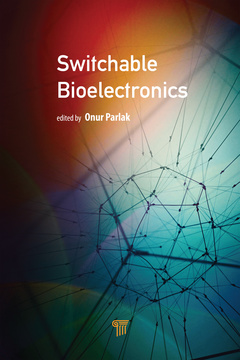Switchable Bioelectronics
Coordonnateur : Parlak Onur

This book reviews the rapidly emerging field of switchable interfaces and its implications for bioelectronics. The authors piece together early breakthroughs and key developments and highlight the future of switchable bioelectronics by focusing on bioelectrochemical processes based on mimicking and controlling biological environments with external stimuli as well as responsive systems for drug delivery. All chapters in the book strive to answer the fundamental question: How do living systems probe and respond to their surroundings? Following on from that, how can one transform these concepts to serve the practical world of bioelectronics? The central obstacle to this vision is the absence of versatile interfaces that are able to control and regulate the means of communication between biological and electronic systems. This book summarizes the overall progress made to date in building such interfaces at the level of individual biomolecules and focuses on the latest efforts to generate device platforms that integrate biointerfaces with electronics.
Chapter 1 introduces the general concept of dynamic interfaces for bioelectronics and gives an overview of the importance of materials and systems for switchable bioelectronics, introducing the reader to different biointerfaces. Chapter 2 pieces together different types of stimuli-responsive polymers and applications. Chapter 3 lays special emphasis on stimuli-responsive polymers with tunable release kinetics and describes the importance of polymer design for delivery applications. Chapter 4 reviews the field of conformational switching in nanofibers for gas-sensing applications. Finally, Chapter 5 focuses on molecular imprinting polymers as recognition elements for sensing applications.
As informative as it is lucid, this handbook makes an essential resource for advanced undergraduate- and graduate-level students in chemistry, as well as researchers in polymer science and electrochemistry, especially those with an interest in responsive polymers and biosensors.
Introduction to dynamic bioelectronic interfaces. Stimuli-responsive systems and applications. Stimuli-responsive polymers with tunable release kinetics. Conformational switching in nanofibers: a new bioelectronic interface for gas sensors. Molecularly imprinted polymers as recognition and signaling elements in sensors.
Onur Parlak received his PhD in bioelectronics from Linköping University, Sweden, in 2015. He then received the Wallenberg Fellowship and joined Alberto Salleo’s Lab at Stanford University for postdoctoral research focusing on wearable bioelectronics. Subsequently, he returned to Sweden and joined the Department of Neuroscience at Karolinska Institute to translate his engineering skills in medical settings. Since 2019, he has been leading his research in the newly established Center for the Advancement of Integrated Medical and Engineering Science (AIMES) at the Karolinska Institute, where he specializes in digital medicine by generating new concepts and devices in the area of biosensors and bioelectronics.
Date de parution : 04-2020
15.2x22.9 cm
Disponible chez l'éditeur (délai d'approvisionnement : 15 jours).
Prix indicatif 143,25 €
Ajouter au panierThèmes de Switchable Bioelectronics :
Mots-clés :
PVDF Nanofibers; switchable interfaces; FET Device; bioelectronics; pH Responsive Polymers; electronic systems; Stimuli Responsive Polymers; switchable bioelectronics; Tri-block Copolymer; versatile interfaces; Light Responsive Polymers; PVDF Fiber; Molecular Imprinting; Functional Monomer; Temperature Responsive Polymers; Peg Chain; QCM Sensor; Polymer Brushes; pNIPAAM Polymer; Thermoresponsive Polymers; Molecular Imprinting Technique; Force Extension Curves; Drug Delivery Applications; Drug Release; Release Kinetics; Recognition Element; Photoresponsive Polymers; Dynamic Interfaces; Burst Release; Delivery Systems
